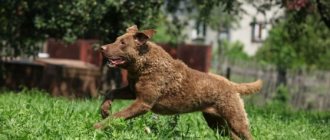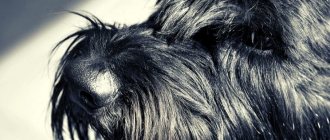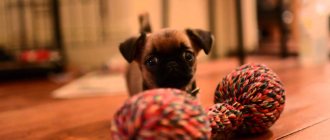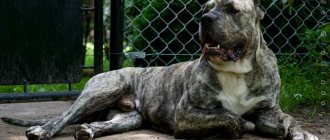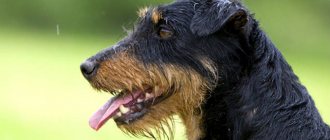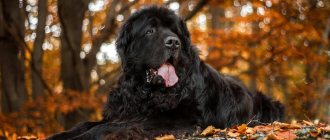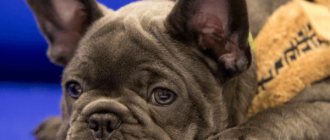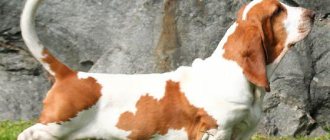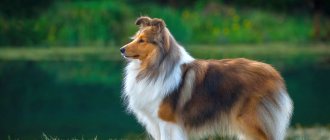History of the Golden Retriever breed
Golden Retriever
The main prerequisite for the emergence of the breed was the eternal passion of English aristocrats for hunting. In the 19th century, the main pastimes of British and Scottish Esquires were game baiting and duck shooting. The venerable peers disappeared for days in the forests and swamps, showing off to each other their trophies, guns and, of course, dogs. However, if the gentlemen had complete order with the hounds, then four-legged hunters, capable of finding a shot quail in the heather thickets or swimming after a duck that had fallen into the lake, were in great short supply. Commercial demand gave rise to supply, and soon shaggy dogs with an unusual golden coat color began to roam the valleys of Scotland.
The appearance of golden retrievers as an independent breed is usually associated with the name of Dudley Marjoribanks, a Scottish lord and part-time amateur breeder. It was he who showed the world a completely new type of hunting dog, which was not afraid of water and could skillfully retrieve a shot bird. For a long time, it remained a mystery whose blood flowed into the lord’s wards, until the secret records of his stud books were made public in the middle of the 20th century. As it turned out, the water tweed spaniel, Labrador, bloodhound and straight-haired retriever gave their genes to the goldens. At the same time, the first offspring was obtained as a result of mating a tweed water spaniel and a straight-haired retriever, which had a yellowish coat.
By the 20s of the last century, the breed was already quite popular not only in Europe, but also among breeders in the New World. In addition, the USA and Canada have formed their own standards of appearance for Golden Retrievers. For example, overseas people preferred individuals with more intense and dark coat color. The descendants of Scottish retrievers were brought to Russia after the collapse of the USSR, all from America. The first purebred dog entered the Russian Federation in 1991.
Appearance of a Golden Retriever
Golden Retriever Puppy
Golden Retrievers are moderately pumped up beauties with soulful eyes and luxurious iridescent fur. Goldens owe their recognition not so much to their own charm as to the efforts of marketers. American cinema promoted the breed especially actively. It is enough to watch a couple of comedy melodramas produced in the USA to understand: if an American family ever decides to get a dog, then in 9 cases out of 10 it will be a Golden Retriever.
The sexual type of representatives of this breed is clearly expressed. The height of the average boy ranges from 56-60 cm, and his weight can reach 41 kg. Girls are much lighter (average weight - 25-37 kg) and smaller than males (height - 51-56 cm).
Despite the presence of a single breed standard approved by the FCI, experts divide golden retrievers into three types:
- English;
- American;
- Canadian.
Representatives of the first group are natives of Foggy Albion, with extremely massive paws and a wide skull. They are distinguished by a lighter coat color, up to white. It is the English type that is most common in Europe and Russia. The complexion of the wards of American breeders is less impressive, but golden retrievers “made in the USA” can boast of graceful posture and a generally more elegant appearance. At the same time, the shade of their coat is slightly darker than that of their British counterparts. A distinctive feature of Canadian retrievers is their thin build and fairly tall stature. The coat color of the “Canadians” is even more rich and dark than that of the “Americans”.
English type golden retriever
American Golden Retriever type
Canadian type of golden retriever
Head
The skull is massive, convex-angular. The transition from forehead to muzzle is distinct and smooth. The occipital protuberance is smoothed, the cheeks are flat. The animal's muzzle is long, smooth, gradually tapering from the base to the nose.
Lips
Golden Retriever
Black, moderately dense and dry. The upper lip hangs noticeably over the lower lip, but does not extend beyond the jaw. The lips completely hide the dog's teeth and gums, forming small folds at the corners of the mouth.
Jaws and teeth
The retriever's jaws are strong and quite wide, with a pronounced scissor bite. The teeth are white and large. The incisors are located along the same line.
Nose
The lobe is massive, mobile, black. The nostrils are wide open.
Ears
Moderately long, hanging, hanging along the animal’s cheeks. The base of the ear is wide, the tip is narrow, smoothly rounded. Standing - slightly above the eye line.
Eyes
Large, deep-set, round in shape. The Golden Retriever has an intelligent, friendly look. The color of the iris ranges from brown to dark brown. The eyelids are black, dry, and fit tightly to the eyeball. An important condition: in a dog looking straight, the whites of the eyes should not be noticeable.
Satisfied muzzle of a golden retriever
Neck
Massive, high set and of moderate length. The neck muscles are strong, developed, there are no folds or sagging.
Frame
Retriever family
Adults have a strong, tightly built body with prominent muscles. The back of Golden Retrievers is straight, with a convex loin and pronounced withers. The croup is massive, slightly sloping, round in shape. The chest is of moderate width and quite deep. The tucked abdominal line ends in a short and well-shaped groin area.
Tail
Moderately long, with a wide, thickened base and a cone-shaped tip. Located below the back. A calm Golden's tail is lowered, while an excited Golden's tail is raised to the level of the back.
Limbs
The front legs are muscular, dry, and stand straight. The shoulders are strong, with massive shoulder blades and elbows laid back, pressed to the body. The humeroscapular angle does not exceed 90°. The pasterns are strong, but short, set at a slight angle.
The hind legs are strong, with well-developed muscles, and are spaced at a decent distance from each other. The hock joints of Golden Retrievers are low and point backward. The front and hind legs are of medium size and round in shape. The pads are massive, with short claws, the animal's fingers are folded into a ball.
Wool
The most important passenger
The coat of the Golden Retriever is characterized by increased rigidity and has a water-repellent function. The hair is quite thick and lies tightly to the body, hiding the abundant undercoat. The structure of the coat can be straight or lightly waved, and its length varies depending on the part of the body. The longest coat is located in the chest, ears, body, back of all four legs, and also in the lower part of the tail. Areas of the body with short hair are the head, paws and the front side of the limbs.
Color
All shades of gold are considered reference, up to the transition to cream color. Lighter colors are acceptable for feathering on the paws and tail feathering.
Possible defects
The list of breed defects includes any deviations from the characteristics prescribed by the standard. For example, it is undesirable for a Golden Retriever to have sparse and long hair, white stripes on the chest, and eyes that are too light and too close-set. The following defects may be grounds for not allowing an animal to compete:
- square body;
- long or too short legs;
- malocclusion and distorted lower jaw;
- cryptorchidism;
- lips, eyelids and nose, painted in any shade except black;
- a white “scarf” on the neck and marks on the forehead;
- black color of the coat, as well as the presence of spots on it;
- drooping tail.
Embittered or, conversely, cowardly individuals, animals with small heads, short ears and small teeth will also not make a serious career.
Brief characteristics of the breed representative
The Golden Retriever has such qualities as balance and obsequiousness to the owner. He is strong and resilient (physically developed). The appearance is beautiful, the body structure is foldable. Small size, excellent swimmer skills (the thick undercoat gives the coat a water-repellent effect).
Who is a Golden Retriever suitable for?
The Golden Retriever is suitable for owners who lead an active lifestyle. Sports activities come first for this breed. The dog is active and requires regular training in open areas. If the owner cannot handle the pet on his own, it is advisable to seek help from dog handlers.
The breed is great for families with children. Animals love and protect them. Retrievers are not for home protection. Allergy sufferers should refrain from adopting such a pet because of its long fur.
Who should you choose: a male or a female?
When choosing the gender of your future pet, it is important to rely on your own preferences. The temperament of representatives of the breed of different sexes has some differences.
Males have distinct breed characteristics both in temperament and appearance. They are less affectionate and more active than females. Retriever boys are independent, their mood does not depend on their owner. A little willful. They actively protect their person and his entire family. The downside of a male dog is his love of love during the period of sexual heat. He may run away at the sight of a pretty “girl.” The bitch is more practical. She is affectionate, careful and attentive. Intellectual development is slightly higher than that of males. Concern for children is clearly expressed.
Can I keep it in an apartment?
You can keep a Golden Retriever in an apartment, provided it is spacious. In a small apartment, the dog will not be able to feel free due to high activity. An apartment pet needs regular exercise in the fresh air. If the owner is ready to devote this time to the animal, you can safely make such a friend. The best housing option is a house with an adjacent area for training.
What is better to feed: dry food or natural food?
The best food option is canned. It does not burden the digestive system and combines a balance of vitamins and microelements.
Dry food contains a balanced set of essential substances that promote the proper structure of the skeletal system and maintain good condition of the coat and teeth.
Premium food is chosen. Meals are taken 2 times a day, strictly according to the regimen (the dosage must correspond to the weight).
The animal is prohibited from eating from the owner's table. A natural diet is very difficult to find. It is necessary to calculate the exact amount of calcium and other elements. Otherwise, the skeletal system will suffer.
Is it easy to train?
Golden retrievers are smart and intellectually developed. Quickly grasp command execution skills. Training is carried out in open areas. The main condition is attentiveness. The owner must not be distracted. Otherwise, the dog will lie down and not follow commands.
Training takes place in a playful way. Already at the age of 2 months, the pet knows the basic commands and has the basics of education. Difficulties may arise with endurance training (the weak point of the breed).
Don't delay starting your training. At the age of 1 month, the puppy is able to perceive simple information: respond to a nickname, know its place. During this period, it’s time to develop his parenting skills.
How are retrievers used?
This breed is distinguished by its attachment to humans. Dogs are independent and caring. They are used as companions for people with disabilities. A guide dog of this breed will cope with the task perfectly.
A pet nanny will protect the owner’s children and protect them from possible troubles.
Zootherapy is treatment with the help of animals. Used for the socialization of patients with autism. Helps cope with other mental disorders. Retrievers also cope with this task.
Photo of a golden retriever
Personality of the Golden Retriever
Golden retriever plays with its owner
In terms of the number of enthusiastic reviews from owners, golden retrievers are almost ahead of all breeds. Indeed, only a convinced dog hater would be able to unearth the shortcomings in these good-natured intellectuals. As for ordinary animal lovers, their goldens literally captivate with their softness and phenomenal memory for faces. If one of your friends treated your pet to a tasty treat or entertained him with a simple game, you can be sure that the retriever will not forget to add a fat “plus” to this friend’s karma.
Calm and balanced in everyday life, representatives of this breed try to keep their cool even in the most delicate situations. They are completely non-confrontational and are ready to get along with any four-legged creature that does not show open aggression. Even in the most tense moments, goldens prefer to resolve matters peacefully. A golden retriever growling and clinging to an opponent with a death grip is something out of the realm of fantasy.
The breed is often recommended for keeping in families with children, since in relation to the younger generation the animals are as correct and patient as possible. Of course, entrusting a dog to babies is not the wisest decision, but it is quite possible to leave playful three-year-olds to it. Golden Retrievers are primarily people-oriented. It is with him that they want to go for walks, share their joys and sorrows. For this reason, goldens are often involved in active canistherapy. Shaggy “antidepressants” are happy to contact patients who are in a state of prolonged depression, charging them with bright emotions and gradually returning to them the joy of existence.
Golden retrievers are typical sanguine people, who are not at all characterized by such character traits as suspicion and caution. Strangers arouse curiosity and burning interest in these simple-minded fellows, so if there is a golden in your house, accept the fact that he will not be a guardian of the territory and material assets.
Golden Retriever with a child
This cat has found his place in life
Education and training
Nature has not deprived golden retrievers of intelligence and memory, so the dog grasps any lessons on the fly. The first thing to start training a Golden Retriever puppy is obedience: the animal must understand what is allowed and what is not. Do not give in to the immediate desire to remove all restrictions and pamper your baby, so to speak, as an exception. The pranks of a puppy will quickly cease to seem touchingly funny after a 40-kilogram dog begins to practice them.
Golden Retriever training
In the first months of life, retriever babies try to taste the objects around them, so try to convey to your pet the meaning of the “Fu!” command as quickly as possible. Those who see a future hunter in a Golden Retriever will have to go outdoors more often. A dog can learn to find and bring back a shot bird only when it sees it in person. At first, the skill is practiced on rags and dummies: a homemade stuffed animal is thrown at the puppy to make him want to grab an unfamiliar thing and show it to his owner. Then they smoothly move on to fetching and participation in the hunt.
Six-month-old puppies can be taught swimming and obedience using a whistle, and it will be better if a professional does this. 12 months is the optimal age to start training a dog’s endurance, since when hunting she will often have to sit in ambush so as not to spook the game. The command “Lie down!” does not apply in such cases. It is enough that the pet sits next to you. Memory training exercises are considered very valuable, since a golden retriever is not always able to find game by smell alone.
Two curious faces
Features of caring for a Golden Retriever
Retrievers normally tolerate being kept in an apartment or private house. The main requirement for care is to give the dog due attention and care. Pets do not tolerate loneliness well and begin to get bored. If you want to buy this cute puppy, make sure you can devote time to him.
Unlike many other breeds, the Golden Retriever does not become attached to just one owner, so it can be raised and trained by other family members.
The specifics of caring for an animal are not particularly difficult. It is enough to teach the puppy to adhere to the daily routine and water procedures.
You should also regularly wipe your dog’s eyes with wet wipes or a cotton pad soaked in a herbal decoction. If heavy discharge appears, it is better to show your pet to a veterinary clinic employee. Perhaps such a problem indicates the presence of worms or, for example, the progression of plague. However, in most cases, the eyes become watery due to contamination from dust and debris.
You should take care of your ears from time to time. To clean the ears from dirt, you can use a weak solution of hydrogen peroxide or water.
To prevent tartar, the dog’s teeth are cleaned with a special brush. Otherwise, the yellow plaque will spoil the attractive teeth and deprive the pet of the opportunity to take part in exhibition events.
Maintenance and care
Cream golden retriever puppy
Despite the fact that the main specialization of golden retrievers has always been hunting, it is completely unnecessary for today’s owners of these shaggy “servants” to take up a gun. Tiring runs through forests and swamps can be easily replaced with long walks through parks and meadows. It's great if you take your dog to a country house, away from the highway, where he can run around to his heart's content. Just don’t try to turn your pet into a mongrel and put him in a kennel: the retriever will not appreciate your impulse and will become despondent - so take the dog into the house and do not deprive him of his own company.
Keeping a Golden Retriever in an apartment is a kind of test of the owner’s responsibility and hard work, since the animal will have to compensate for the lack of free space, physical activity and impressions with regular promenades combined with physical activity. Due to their sociable nature, Golden Retrievers do not cope well with being alone. Animals express their uncertainty and fear on surrounding objects: they chew furniture and wires, and damage shoes. The worst punishment an owner can come up with for a golden dog is to lock it up within four walls and quietly go to work. For careerists, workaholics, travelers and other busy individuals, a golden retriever as a pet is not an acceptable option.
What not to do with a Golden Retriever:
- allow children to sit on an older dog, since the pressure created by the child’s body can cause the animal’s back to bend;
- pet the puppy on the head and put a collar over its head, which leads to incorrect ear set;
- pull the baby by the paws or try to lift him, fixing his hand under the chest.
Hygiene
The main problem for the owner of a golden retriever is the fur of his pet. During the molting period, the golden leaves furry marks wherever possible, and daily scratching helps little. There are only two ways out of this situation: not to buy a golden retriever at all, or to come to terms with this peculiarity of the dog and purchase a powerful vacuum cleaner to clean up the scraps behind it from time to time.
And some water for me!
Brush your shedding retriever twice a day using a brush and a mitt to collect hair. Dense undercoat is removed with a furminator or slicker. To remove dog smell from fur, you can moisten it with a solution prepared according to the following recipe:
- mix a glass of water with a glass of vodka;
- add 2 tablespoons of vinegar essence;
- add 1 teaspoon of salt and shake.
During the periods between moults, the animal’s fur does not require such careful care, but you will still have to go through the dog’s “fur coat” with a comb a couple of times a week. Goldens are given a bath once a month and that is quite enough. After bathing, you can slightly shorten your pet's fur. The hair is cut from bottom to top, starting from the neck. It is not forbidden to use scissors to go through the fur on the dog’s paws and “pants.” The hair growing between the toes and at the base of the tail should also be trimmed regularly.
Most Golden Retrievers have unproblematic eyes and ears, so a standard weekly checkup is sufficient. If dirt has accumulated in the ear specula, you can remove it with a napkin and boiled water. Chilled tea leaves are suitable for treating the eyes. Cleaning your Golden's teeth is a labor-intensive process, but necessary. If you can’t clean your mouth using the classic method, you can entrust this task to dry food or special treats, whose solid particles act as abrasives that “erase” plaque.
Feeding
It's someone's birthday today
Golden Retrievers can be fed both natural foods and dry food. In the first case, about 50% of the diet should come from animal protein, that is, meat. The daily norm of the product is calculated as follows: 10-20 grams of meat per kilogram of dog weight. The remaining half of the retriever’s daily “menu” consists of cereals and vegetables.
Meat for dogs is selected to be lean, with a lot of veins and cartilage. Beef, lamb, rabbit and turkey are ideal. By-products are also not prohibited, but due to the digestive upset that they can provoke, they are introduced into the diet gradually and little by little.
Important: Golden Retrievers are fed after a walk, not before it.
It is better to cook thick porridges from rice and buckwheat, to which you can add stewed vegetables. Pumpkin, carrots, cabbage, turnips and beets are especially beneficial for golden retrievers. During the season, early greens are mixed into the porridge. It is not forbidden to include fermented milk products - kefir, yogurt, cottage cheese - in the diet of an adult dog. Puppies, whose skeleton is still developing, require more calcium, so for up to 4 months, the diet of small goldens must include milk (whole and as part of porridge).
Approximate daily menu for a 4-month-old baby: 300 g of meat, 100 g of sliced fruits and vegetables or vegetable stew (apple + carrot), 500 g of porridge with milk.
Trick or treat
Golden retriever on the beach
How many times to feed
Until 4 months, golden retriever puppies receive food 5 times a day. Starting from 5 months, babies are transferred to four meals a day. Six-month-old adolescents eat three times a day, and by 8 months the puppies completely switch to twice feeding.
Walk
Walk golden retrievers at least two hours a day. However, it is not at all necessary to maintain the same duration of walks. For example, the morning promenade can be reduced to 30 minutes, and the evening promenade, on the contrary, can be increased to one and a half hours. If the animal lives in an apartment, then until four months it should not be allowed to go up and down stairs on its own. Take the puppy for a walk in your arms and bring him into the apartment in the same way.
Babies are taken outside more often than adults to develop the skill of using the outdoor toilet. First, excursions are conducted through park areas, gradually moving to busy city streets. It is very important that the dog does not fall into a stupor at the sight of people and the sounds of public transport, so the more often it encounters everyday phenomena in the urban environment, the faster it will learn to perceive them adequately.
Privacy with the owner
Golden Retrievers and Water
Golden retriever playing in a mountain river
Golden retrievers love water treatments, so during a walk the puppy will certainly try to measure the depth of the first puddle it comes across. Accordingly, if you notice a pothole filled with water on the way, it is better to prevent the animal from rushing by taking it by the collar and strengthening the prohibition with the command “No!” If the moment is missed, and the pet is already swimming in a puddle with all his might, shout at him (the same command “Ugh!” will do) and throw a leash at him. You should not go into the water and try to pull the dog out. Wait for her to obey the command and praise her for her obedience. But you shouldn’t give up swimming in open waters. Swimming in a pond, river or lake for a dog is gymnastics and psychotherapy in one bottle, so when going for a weekend in nature, feel free to take your golden dog with you.
Characteristics and description of the breed
The popularity of golden retrievers is increasing year by year. More than 70 thousand of these dogs are registered every year in American clubs alone. The love for these animals is caused by their character - they are kind, well-mannered and playful, so any family will simply be delighted with them.
Aggressiveness
Depending on what kind of dog a Golden Retriever sees next to him, he may behave differently. This breed reacts as follows:
- when near small dogs, retrievers try not to approach them first, since they are not interested in them;
- They are wary of larger dogs and first look closely before starting communication.
Golden Retrievers are friendly towards people. They love when their owner plays with them and pays a lot of attention.
Activity
Golden Retrievers are very active dogs. They can spend the whole day on the move, practically without stopping. They can always find something to do that suits their rhythm, but most of all they love it when their owner devotes his time to them.
Training
No matter how smart a dog is, it still needs training. With golden retrievers, training will be much faster than with other breeds, as these pets pick up everything on the fly.
Retrievers not only remember commands, but are also capable of some circus tricks, for example, “agility” or “freestyle”.
Shedding
Many owners of Golden Retrievers claim that these dogs only shed heavily in the spring, when the warming winter coat becomes a burden. In bitches, shedding directly depends on the cycle, so they should pay special attention.
It is necessary to monitor the retriever's diet, as this can affect hair loss.
Need for care
The Golden Retriever is a breed of dog that is simply not capable of living in a kennel; it is more accustomed to an apartment environment. For this reason, before purchasing a puppy, you need to understand how much time you can devote to it. Caring for a retriever is quite simple, but before this, the pet needs to be trained to use the tray from childhood. Some procedures must be carried out regularly, once a month or a week.
Friendliness and attitude towards children
It’s not for nothing that Golden Retrievers are called babysitters, because they love to spend time next to small children. Not only are they friendly and affectionate with them, but they can also calm them down if they sense that the children are worried about something. Retrievers often offer to play to distract the kids.
Trusting very young children with dogs is a dubious idea, but three-year-olds will definitely be able to find a common language with retrievers.
Health
Despite the fact that the retriever has innate instincts and hunting abilities, nature has not endowed it with good health. They are genetically predisposed to various types of diseases:
- obesity (you cannot overfeed these dogs, as they can gain a lot of excess weight in a short period of time);
- oncology;
- hip dysplasia, in which the dog feels constant pain and may limp;
- cataracts and entropion;
- skin diseases;
- cardiovascular diseases.
Attitude towards loneliness
It is not a good idea to leave golden retrievers alone in an empty apartment or house for a long time, as they may get bored. This breed can tolerate a few hours without their owner, but being alone all day will be an impossible task for them.
Maintenance cost
The initial expenses will be the largest and will range from 5 to 10 thousand rubles. This price includes bowls, toys, vaccinations, food and other necessary items for your pet. In subsequent months, expenses will be about 2.5-3 thousand.
If you want to take your dog to exhibitions, then the fee for participation in one event of this type will be 1-1.5 thousand rubles.
Intelligence
Golden Retrievers are intelligent and intelligent dogs, which is why they are so trainable. According to Stanley Coren, this breed ranks fourth in the list of the most developed dogs.
Noise
Despite their activity, golden retrievers are characterized by silence and patience. They don’t make a fuss over any little thing and don’t annoy you with causeless loud barking.
Security qualities
The Golden Retriever does not have any protective qualities. A dog is not able to protect its owners from attack.
However, with the help of a course of special training, security qualities can be slightly improved.
Lifespan
The average life expectancy of golden retrievers is 11-12 years.
Health and Diseases of Golden Retrievers
Retrievers resting after a walk
For veterinary clinics, goldens are one of the most profitable pets, and their owners are one of the most frequent visitors. The main diseases of the Golden Retriever, mentioned in almost every reference book, are retinal degeneration and hip dysplasia. However, in fact, the breed is also associated with about a dozen different ailments. For example, dogs are often diagnosed with cancer and heart diseases, hypothyroidism, atopic dermatitis, von Willebrand disease and other dangerous ailments.
In addition, Golden Retrievers are prone to obesity. Compared to more serious illnesses, excessive weight seems like a harmless trifle, although in reality everything is not so rosy. Animals that have put on extra pounds live shorter lives, and those with excess body weight suffer more from the constant companion of all older dogs - arthritis. An animal’s diseased teeth also pose a serious danger. An ordinary abscess on the gum or an inflamed tooth can “spread” the infection throughout all the organs of the retriever, ultimately sending him to doggy heaven.
What is the difference between a Golden Retriever and a Labrador?
Labrador and golden retriever have similar appearance. Their addition is equally proportional. The retriever looks more aristocratic due to the massiveness of the Labrador.
The Golden's coat is long, straight or wavy. The Labrador's coat is smooth and lies close to the body.
The breeds also differ in color. Labrador retrievers come in fawn, black or brown. Such colors are not typical for a retriever. The difference is also noticeable in the tail. The Labrador has a smooth tail, similar to an otter's tail. By nature, both breeds are playful; the Labrador is distinguished by trustfulness and simplicity. The retriever shows aristocracy and accuracy.
How to choose a puppy
- When going to the nursery, arm yourself with a printout of the breed standard, or better yet, take with you a specialist who will help you choose a puppy. If this is not possible, contact any of the kennel clubs, where they will recommend you a reliable breeder.
- Puppies inherit from their parents not only their appearance and hunting qualities, but also their temperament type, so when talking with the seller, insist on getting to know the mother and father of the babies. If such a favor is refused to the buyer, there is a high probability that the pedigree of the dogs is so-so.
- For those who see a future family friend in a golden retriever, it is better to purchase bitches that are more docile and affectionate. Golden males are distinguished by their bright charisma, but their character is more serious and firm. In addition, boys are much smarter when it comes to hunting.
- The temperaments of American and European retrievers differ significantly - take this fact into account when buying a puppy. Goldens from the USA are more energetic and emotional. Native “Europeans” are noticeably more phlegmatic and do not suffer from hyperactivity.
- Responsible breeders who value their own name have puppies that are well-groomed, vaccinated and treated with anthelmintics.
Appearance (breed standards)
The basic standards of appearance for a Golden Retriever are as follows:
- The dog's coat is long, slightly wavy, but generally straight;
- the retriever has a waterproof undercoat;
- the color is all cream and golden shades;
- puppy height – 31 cm, female – 51-56 cm, male – 56-61 cm;
- The weight of a puppy reaches 7-8 kg, an adult female – 25-37 kg, a male – 26-41 kg.
Head
The head of this dog breed is beautiful, with an elongated muzzle.
Eyes
The dog's eyes are almond-shaped and range in color from light hazel to dark brown.
Ears
The retriever's ears are drooping and shaped like a triangle.
Jaws
Retrievers have powerful jaws with large canines and a claw-like bite.
Torso
The dog's body is elongated, its stomach is tucked.
Neck
The neck of dogs of this breed is strong and strong.
Tail
The dog's tail is long and slightly pubescent.
Paws
A retriever's legs are muscular, and its paws resemble those of a cat, only with hard pads.
Wool
The guard hair of a retriever is beautiful, straight and long. Retrievers have a slightly wavy coat.
Color
The color of dogs of this breed includes golden, cream, and beige shades. According to the standard, red tones are undesirable.
Photos of golden retriever puppies
How much does a golden retriever cost?
Pet-class puppies remain the most attractive option in terms of price: from 20,000 to 25,000 rubles. Almost invisible defects in appearance significantly reduce the cost of a golden retriever, which will especially appeal to those who do not dream of exhibitions and championship titles and are not averse to saving money. Prices for show class start from 35,000 rubles. and end around 50,000 rubles. An option designed for the most generous buyers is offspring obtained from interbreeding, with the right to further breeding. The cost of such a puppy is 70,000 - 80,000 rubles.
Advantages and disadvantages of content
We can sum it up by outlining all the pros and cons of owning a golden retriever.
Advantages
- Friendly, loyal dog.
- Easy to learn.
- It has a very impressive and bright appearance. With proper care, it can become a participant in exhibitions and competitions.
- Adapted to life in urban environments.
- You can get a dog for a child: retrievers get along with children and are easy to train.
Flaws
- Strong odor (may be a sign of stomach problems).
- A huge amount of wool throughout the apartment: on the floor, in the bathroom, in your soup and even in the air.
- Requires attention from the owner, otherwise it can spoil things.


